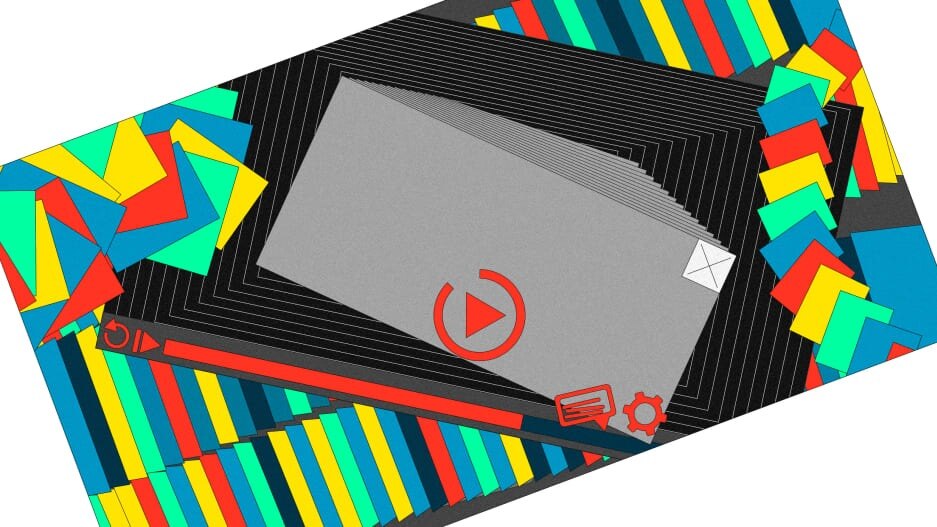- | 8:00 am
From Netflix to HBO, the terrible design of streaming is ruining TV
Streaming services have perfected the art of bad design.

Everyone loves streaming video services. At the same time, everyone loathes streaming video services. It doesn’t matter if it’s Netflix, Apple TV+, Amazon Prime Video, Disney+, HBO Max—for every great series or film we watch on the platforms, there’s a half-dozen things we hate about the actual experience of doing so.
“They’re all so terrible. I don’t want to say because I work for all of them. But they’re all bad,” Stephen Schiff confessed to Variety in a recent streaming-services hate fest. It appears Schiff, an executive producer and writer on FX’s The Americans, is far from alone in his sentiment.
Streaming platforms have become an essential part of many people’s lives—87% of all American households subscribe to at least one service. On average, a person in the U.S. subscribes to 2.8 streaming services, and 10% pay for more than 5 streaming services at any given time. It’s easy to see why. They all offer practically unlimited series and films on demand—a major convenience over the traditional network television model. But all of them suffer from terrible user experiences that can make finding and watching streaming content sometimes as pleasant as eating thumbtacks and cheese tacos—through your nose.
Each platform has its own flavor of bad. On Apple TV+, for example, the “continue watching” menu is hidden under the fold. Good luck watching the credits on Netflix—they automatically skip to serve up a new episode. Hulu makes viewers hunt for the very show they were just watching. And Amazon Prime has turned its streaming service into an all-you-can-eat buffet of video content that requires watchers to surf its interface as if they were looking for the best deal on toilet paper.
Across the board, the streamers have terrible landing pages and subpar curation algorithms. Playback buttons routinely fail to work properly, and using the time slide to scrub to the right point in the video still feels as fun and precise as playing Tetris with your toes.
In a silo, these UX sins are an annoying, but ultimately ignorable, trade-off for easy-to-access content. But it’s 2023, and really, there’s no excuse for an entire genre of digital tools to so blatantly ignore the basics of good design. I had to wonder: Why do the platforms that are supposed to bring us pleasure seem passionately invested in planting anti-UX mines all over their interfaces? I asked a few experts in the field for their take.

FUNDAMENTALLY WRONG
The most glaring issue with the streaming interface is how hard they make it to keep watching a show. On AppleTV+ and Disney+, in particular, finding the “continue watching” feature requires a long scroll. “As UX designers and users of these services, we find this extremely annoying,” Carsten Wierwille tells me over an email interview.
Wierwille, CEO of digital design studio Ustwo, blames the entertainment industry’s fear of the new. Instead of reinventing the TV experience, as streaming promised to do, the platforms have copied some of cable’s worst traits in a quest to hook viewers and maintain subscriptions. Wierwille ventures that the buried “continue watching” menu is likely the victim of marketing objectives. Streamers reserve the prime screen real estate to promote new or popular content, which he says fits with traditional TV design patterns of prioritizing content based on who pays the most for “preferred placement” rather than prioritizing the user needs.
“One could say it is the old grocery store trick of putting frequently purchased items like milk in the back of the store to create more temptation,” he says. In the case of streaming, the service decides what to promote based on its own internal objectives for each series and metrics—a secret formula that seemingly nobody has access to, not even the shows’ producers.
Zac Snider, design lead at Ustwo, agrees that there’s a clear prioritization of promoting new shows over getting back into content you are already watching. “Streaming services care about hours of content watched and subscriber growth, not that folks completed a series,” he says. “What’s more important: that we finished all of Glow (at about 22.5 hours of content) or that I watched 8 shows halfway (at about 80 hours of content)?” This is why emphasis on “discovery” is so important. It’s the same reason why these services cut the credits to take you to the next episode within seconds. They need you running in that hamster content wheel for as long and as fast as possible.
Good UX is often in contention with the business needs of a platform. What users want and what businesses need are routinely at odds. “Typically, we see UX taking the brunt of it when [business] issues arise,” says Fura Johannesdottir, global chief creative officer at Huge. “And although these streaming services conduct months and sometimes years of testing, decisions are made that may not take into consideration the user experience, but rather, focus on aligning with the current business model.”
Johannesdottir says it’s a no-brainer that the “continue watching” section should come first. But she also believes it could be enhanced with features that make it even more usable, like adding a “remove from queue” option that allows users to take off specific shows and movies that no longer interest them. It might seem at odds with the streamers’ business directive for getting more people watching, but a simple feature like this could also more accurately train the algorithm on what viewers actually like and would want to watch more of.

A CLEAR OPPORTUNITY
According to Gabriel Marquez, managing director at Ustwo, these UX problems may be all about growing pains. “There were platforms springing up every few months and tens of billions being spent on content to populate them. Now it’s starting to sort itself out a bit,” he says. “We’ve gone from radical atomization (a service for seemingly every channel!) to rapid acquisition and centralization to a few platforms. So it’s been hard for UX to keep up as companies have had to absorb and be absorbed and had different strategies.”
The core mission of these streaming platforms should be to support the user journey and needs, but they’re far behind other popular consumer applications: “We envision a service that works more like Google Maps, which is incredibly good at anticipating user needs and search based on personal location and history,” Wierwille says.
Johannesdottir thinks that it’s important for streaming services to put the power in the hands of the users, allowing them to choose their own experience. But there’s more than that. “I actually think this is bigger than a UX problem, I think it’s a problem with value propositions and brand purpose,” she says.
Right now, everyone is doing the same thing: producing a lot of stuff and trying to smash it against our retinas, but perhaps there should be an alternative. “It’s not healthy,” Johannesdottir continues. “I would love to see some of the streaming services take a stand and instead of asking you to ‘continue watching,’ they would ask you to take a break and ‘continue’ to do something else.”
Chris Marotta, a design principal at Ustwo, believes that none of the services take into account the user’s emotional state. “After an emotionally draining episode of The Last of Us, why would I want to immediately watch something about serial killers? These streaming services have an opportunity to anticipate my mood and adjust accordingly,” he says. Instead, they try to force-feed you more content like what you just watched, apparently to turn your brain into foie gras.
Perhaps Apple TV can actually achieve this goal, Johannesdottir muses, since it controls a giant walled garden that connects fitness, music, activities around you. “There is something interesting about being a responsible content provider that I think could be an interesting value proposition on its own,” she says.
At the moment, streaming platforms are nearly indistinguishable in their UX. They’re all overloaded with content and cramped with terrible features. They form an ocean of mediocrity full of bad decisions made by bean counters and Hollywood execs. But that means there is a massive opportunity to rethink the experience from scratch.
Maybe the streaming wars will not be won by the platform with the most or best content, but by the one that can give us an experience that we can enjoy from the very moment we click on the app.







































